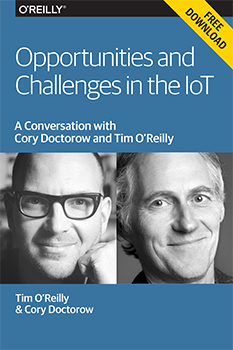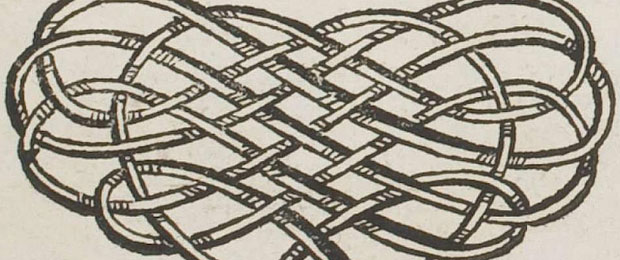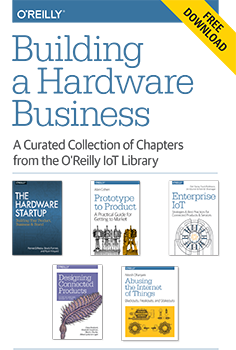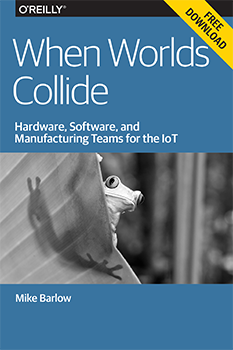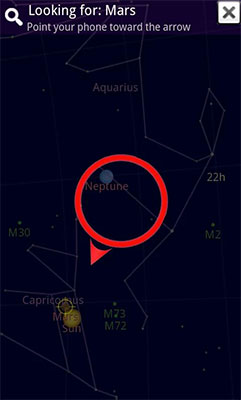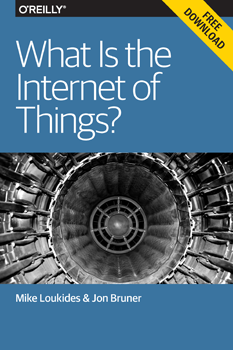"Solid" entries

Driven by the Internet of Things: A mountain bike with a voice
Listening to things in the IoT will redefine manufacturing.
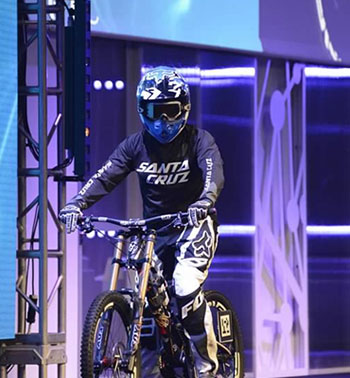
Image courtesy of PTC.
Previously, manufacturers relied on customer feedback to maintain and upgrade products; now, product analytics can fix issues before they happen — and create new opportunities for product design and service. This is done by listening to the “voice of the product or data,” where manufacturers can gather, interpret, and feed product data back into the design cycle, enabling a new set of capabilities that builds value for manufacturers and customers, all driven by the IoT.
Imagine listening to the “voice” of a Santa Cruz mountain bike. The bike, pictured above at the opening of the Boston-based IoT event LiveWorx, demonstrates how physical products can be dissected to their digital cores and this knowledge used to predict and resolve problems. The bike, fitted with sensors and a Raspberry Pi computer for connectivity, tracked wheel speed, suspension pressure, and angle of the steering wheel — all of which was connected to the cloud using our ThingWorx IoT platform. As it was ridden around the stage, its motions were displayed inside a computer-aided design (CAD) model. Combining the power of CAD and product lifecycle management (PLM) with our IoT platform, we merged the bike’s real-world physical interactions into the digital world, creating a “digital twin,” an exact digital representation of the physical bike. Read more…

“The purpose of the IoT is to give humans superpowers”
Tim O’Reilly and Cory Doctorow talk about the opportunities and challenges presented by the Internet of Things.
Taking a look at industry, O’Reilly addressed a Twitter question from @leahthehunter regarding which companies and technologies are most profoundly impacting the evolution of the Internet of Things:
I think the biggest mistake people make with the Internet of Things is in thinking that it’s about devices. Sure, there are sexy devices: your Nest thermostat. Your Internet-connected drone, or whatever, and people go, ‘Oh, awesome.’ Yes, and there’s things like smart TVs, but the biggest impact to me seems to be when you start thinking about how sensors and devices can change the way you actually do things. … What really seems interesting is if you take Uber as a model of an Internet of Things company and use that as your icon rather than, say, Nest, you say, ‘Oh wait a minute — what’s really happening here is we’re saying once you have connectivity and sensors out in the world, you can actually completely rethink an industry.’
O’Reilly noted that the biggest opportunities in the IoT lie not in new devices but in rethinking user behavior to design better user experiences and increase value for users. Doctorow agreed, pointing out that he’s interested in the notion of “treating human beings as things that are good at sensing and not things that are there to be sensed.” Read more…

What to see at Solid
A look at the interdisciplinary learning paths you'll find at Solid.
Flipping through the schedule for our Solid conference, you might wonder why we offer talks on synthetic biology in the same program that includes sessions on smart factories and how to ship goods within supply chains. The answer is that Solid is about a nascent movement — new hardware — that draws on a lot of different areas of expertise. It’s about access and the idea that physical things are becoming easier for anyone to create and engineer. Understanding hardware and the Internet of Things, then, is critical for every technologist and every company.
Solid’s program has emphasized interdisciplinary learning from the beginning; we’ve seen that a smart, accessible, connected world will need contributions from a lot of different backgrounds: designers, electrical engineers, software developers, executives, investors, entrepreneurs, researchers, and artists.
The keynotes that we’ve lined up will provide an overview, and a sense of how widely impactful this idea is; they touch on design, manufacturing, urban futures, synthetic biology, government, innovation, and techno-archaeology (a topic we’ve explored in the Solid Podcast). And they’ll wrap up with a thought-provoking talk — with a demo — on how we experience flavor.
After lunch on Wednesday and Thursday, the program gets broad.
I’ve drawn up a handful of paths that you might consider taking as you go through Solid next week. None of these is a comprehensive program, but they’ll serve as jumping-off points for different members of the new hardware community. Read more…

The IoT will be as fundamental as the Internet itself
Time, technology, and adoption are creating IoT momentum.
Download a free copy of “Building a Hardware Business,” a curated collection of chapters from our IoT library. Editor’s note: this post is an excerpt from “Enterprise IoT: Strategies and Best Practices for Connected Products and Services,” by Dirk Slama, Frank Puhlmann, Jim Morrish, and Rishi M. Bhatnagar, which is included in the curated collection.
If you did a Google search for “IoT” in 2012, the top results would have included “Illuminates of Thanateros” and “International Oceanic Travel Organization.” A search for “Internet of Things” would have produced a results page with a list of academic papers at the top, but with no advertisements — a strong indicator, if ever there was one, that in 2012, few people spent marketing dollars on the IoT. Two years on, and this had changed dramatically. In 2014, the IoT was one of the most hyped buzzwords in the IT industry. IT analysts everywhere tried to outdo each other’s growth projections for 2020, from Cisco’s 50 billion connected devices to Gartner’s economic value add of $1.9 trillion.Until we have reached this point in the future, no one can tell just how realistic these predictions are. However, the excitement generated around these growth numbers is significant, not least because it highlights a general industry trend, while also creating a self-fulfilling prophecy of sorts. We saw something similar happening with the auctioning of new mobile spectrum in the early 2000s. Literally billions were invested in the mobile Internet. And although it took longer than expected (remember the WAP protocol?), the mobile Internet eventually took off with the launch of Apple’s iPhone, and has since exceeded market expectations.
Meanwhile, Google — another major player in the mobile Internet sphere — has bet heavily on the IoT with its acquisition of Nest and Nest’s subsequent acquisition of DropCam. 2014 also saw many large IT vendors, such as PTC with its acquisitions of ThingWorx and Axeda, pushing themselves into pole position in the race for IoT supremacy. On the industry side of things, many central European manufacturers and engineering companies rallied around the Industry 4.0 initiative, which promotes the use of IoT concepts in manufacturing. GE heavily promoted the Industrial Internet and spearheaded the establishment of the Industrial Internet Consortium. Many industrial companies began implementing IT strategies and launching IoT pilot programs. And slowly, the first real results emerged. Read more…

The 11 deadly sins of product development
Creating great hardware and software means avoiding these product-killing pitfalls.
Editor’s note: This post is an excerpt from “Prototype to Product: A Practical Guide for Getting to Market,” by Alan Cohen.
Thomas Edison famously said that genius is “1% inspiration, 99% perspiration,” and his observation holds true for product development. Developing “genius-level” products certainly requires inspiration, but the bulk of the effort is more like perspiration: work that benefits from insight and cleverness, but is also largely about not screwing up. Most product development efforts fail. It’s been my observation that failures are not usually due to a lack of inspiration (i.e., poor product ideas), but rather from mistakes made during the “perspiration” part.What follows is a brief catalog of the most popular ways to wound or kill product development projects. Most efforts that get derailed do so by falling into one or more of a small set of fundamental traps that are easy to fall into, but are also fairly avoidable. As an organizational construct, I refer to the specific traps as sins and the more-general negative impulses behind the sins as vices. And since these sins are often fatal, I call them deadly sins to remind ourselves of their degree of danger. Before we get into the specific vices and sins, let’s start off with the fundamental principle that lies behind all of these, a basic truth that largely determines success or failure. Read more…

Building functional teams for the IoT economy
Experts weigh in on more fluid approaches to IoT team building.
Download a free copy of our new report, “When Worlds Collide: Hardware, Software, and Manufacturing Teams for the IoT,” by Mike Barlow. Editor’s note: this post is an excerpt from the report.
You don’t have to be a hardcore dystopian to imagine the problems that can unfold when worlds of software collide with worlds of hardware.When you consider the emerging economics of the Internet of Things (IoT), the challenges grow exponentially, and the complexities are daunting.
For many people, the IoT suggests a marriage of software and hardware. But the economics of the IoT involves more than a simple binary coupling. In addition to software development and hardware design, a viable end-to-end IoT process would include prototyping, sourcing raw materials, manufacturing, operations, marketing, sales, distribution, customer support, finance, legal, and HR.
It’s reasonable to assume that an IoT process would be part of a larger commercial business strategy that also involves multiple sales and distribution channels (e.g., wholesale, retail, value-added reseller, direct); warehousing; operations; and interactions with a host of regulatory agencies at various levels of government, depending on the city, state, region, and country.
A diagram of a truly functional IoT would look less like a traditional linear supply chain and more like an ecosystem or a network. The most basic supply chain looks something like this: Read more…

Pop-up factory
An experiment at Solid tests a manufacturing style pioneered by pirates.
A few years ago, I was lucky enough to take a tour of the South China manufacturing ecosystem with Andrew “bunnie” Huang. One of the most fascinating things that I saw there were the markets full of funny little mobile phones: Read more…

The state of augmented reality
A look at AR today and how we need to design it for tomorrow.
Attend O’Reilly’s Solid Conference, June 23–25, in San Francisco. Solid is our conference exploring how the collision of software and hardware is fueling the creation of a software-enhanced, networked physical world. Helen Papagiannis will speak at Solid on June 24.
Unlike virtual reality (VR), augmented reality (AR) provides a gateway to a new dimension without the need to leave our physical world behind. We still see the real world around us in AR, whereas in VR, the real world is completely blocked out and replaced by a new world that immerses the user in a computer generated environment.AR today
The most common definition of AR to date is a digital overlay on top of the real world, consisting of computer graphics, text, video, and audio, which is interactive in real time. This is experienced through a smartphone, tablet, computer, or AR eyewear equipped with software and a camera. Examples of AR today include the translation of signs or menus into the language of your choice, pointing at and identifying stars and planets in the night sky, and delving deeper into a museum exhibit with an interactive AR guide. AR presents the opportunity to better understand and experience our world in unprecedented ways.
AR is rapidly gaining momentum (and extreme amounts of funding) with great advances and opportunities in science, design, and business. It is not often that a whole new communications medium is introduced to the world. AR will have a profound effect on the way we live, work, and play. Now is the time to imagine, design, and build our virtual future. Read more…

Rebooting a 1970s satellite with modern software and hardware
The O'Reilly Solid Podcast: Dennis Wingo on reestablishing contact with a satellite that had been silent for 17 years.
Subscribe to the O’Reilly Solid podcast to stay on top of topics related to the Internet of Things, hardware, software, manufacturing, and the blurring of the physical and virtual worlds.
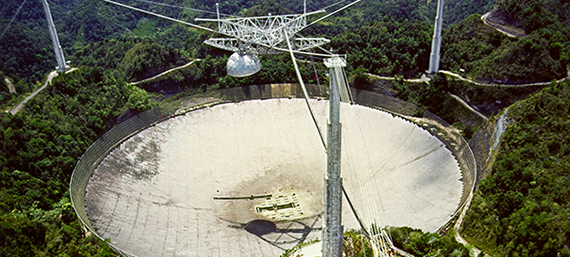
The Arecibo Observatory in Puerto Rico, where Dennis Wingo and his team established contact with the ISEE-3 satellite. Public domain image: Wikipedia.
In the first episode of the Solid Podcast, we talked with Dennis Wingo, founder of Skycorp, in the former NASA McDonald’s where he’s been restoring the first images of the moon taken from space.
After an hour of recounting his techno-archaeology exploits — reverse-engineering the arcane analog image-transmission systems that NASA’s engineers developed in the 1960s — Dennis paused and said, “and that’s just one of our history projects.”
That teaser is where we begin today’s episode. Ready to apply modern computing to another analog challenge, Dennis turned his attention to the reboot of the International Sun/Earth Explorer-3, a research satellite launched in 1978 and commended to the heavens in 1997.
NASA decommissioned the equipment for communicating with the satellite in 1999, so Dennis set about reverse-engineering the ISEE-3’s control system and devising a way to communicate with it. In the 1970s, he would have needed custom analog hardware, but now, general-purpose hardware is powerful enough that he could do it all with software. Read more…

The Internet of Things is really about software
Our new report, "What is the Internet of Things," traces the IoT's transformations and impact.
One of the reasons that it’s ubiquitous is that it bears on practically everything. A few years ago, many companies might plausibly have argued that they weren’t affected by developments in software. If you dealt in physical goods, it was hard to see how software that existed strictly in the virtual realm might touch your business.
The Internet of Things changes that; the kinds of software intelligence that have already revolutionized industries like finance and advertising are about to revolutionize all the other industries.
Mike Loukides and I have traced out our idea of the Internet of Things and its impacts in a report, “What is the Internet of Things,” that’s available for free here.
As much as we all love the romance and gratification of hardware, the Internet of Things is really about software; the hardware just links the Internet to the rest of the world. If you think of the IoT as a newly developing area in software, it’s easy to draw out some characteristics of it that are analogous to things we’ve seen in web software over the last decade or so. Read more…
